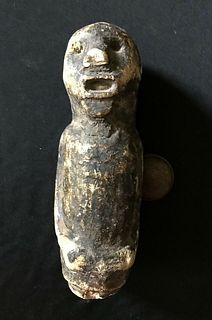Inca Stone Llama Canopa w/ Cinnabar, ex Sotheby's
Lot 82
About Seller
Artemis Gallery
686 S Taylor Ave, Ste 106
Louisville, CO 80027
United States
Selling antiquities, ancient and ethnographic art online since 1993, Artemis Gallery specializes in Classical Antiquities (Egyptian, Greek, Roman, Near Eastern), Asian, Pre-Columbian, African / Tribal / Oceanographic art. Our extensive inventory includes pottery, stone, metal, wood, glass and textil...Read more
Estimate:
$3,600 - $5,400
Absentee vs Live bid
Two ways to bid:
- Leave a max absentee bid and the platform will bid on your behalf up to your maximum bid during the live auction.
- Bid live during the auction and your bids will be submitted real-time to the auctioneer.
Bid Increments
| Price | Bid Increment |
|---|---|
| $0 | $25 |
| $300 | $50 |
| $1,000 | $100 |
| $2,000 | $250 |
| $5,000 | $500 |
| $10,000 | $1,000 |
| $20,000 | $2,500 |
| $50,000 | $5,000 |
| $100,000 | $10,000 |
| $200,000 | $20,000 |
About Auction
By Artemis Gallery
Jul 1, 2021
Set Reminder
2021-07-01 10:00:00
2021-07-01 10:00:00
America/New_York
Bidsquare
Bidsquare : Antiquities | Asian | Ethnographic Art
https://www.bidsquare.com/auctions/artemis-gallery/antiquities-asian-ethnographic-art-7148
Featuring classical antiquities, ancient and ethnographic art from cultures encompassing the globe. Egyptian, Greek, Roman, Near Eastern, Asian, Pre-Columbian, Native American, African / Tribal, Oceanic, Spanish Colonial, Russian, Fossils, Fine Art, more! All legally acquired, legal to sell. Artemis Gallery info@artemisgallery.com
Featuring classical antiquities, ancient and ethnographic art from cultures encompassing the globe. Egyptian, Greek, Roman, Near Eastern, Asian, Pre-Columbian, Native American, African / Tribal, Oceanic, Spanish Colonial, Russian, Fossils, Fine Art, more! All legally acquired, legal to sell. Artemis Gallery info@artemisgallery.com
- Lot Description
Pre-Columbian, Peru, Inca Empire, ca. 1470 to 1532 CE. A wonderful example of a canopic vessel of a hefty form carved from a gray-black stone that is polished until smooth. The llama exhibits characteristic camelid features such as a bulbous body, a drooping tail, a raised head with perky ears, a thick snout, and a wavy, fleecy dewlap hanging in layers beneath the neck. A drilled cavity in the back perhaps held animal fat as an offering to the gods, and remains of its original contents can still be seen and felt within. The head and neck are decorated with faint remains of red cinnabar that show the llama adorned with a bridle as a domesticated animal. Size: 4.7" L x 2.2" W x 3" H (11.9 cm x 5.6 cm x 7.6 cm)
Cf. The Metropolitan Museum of Art, accession number 1994.35.759
Provenance: private New York, USA collection, purchased in 1994; ex-Sotheby's, New York "Pre-Columbian Art" auction (sale 6625, November 15, 1994, lot 239)
All items legal to buy/sell under U.S. Statute covering cultural patrimony Code 2600, CHAPTER 14, and are guaranteed to be as described or your money back.
A Certificate of Authenticity will accompany all winning bids.
We ship worldwide and handle all shipping in-house for your convenience.
#165123Small chips around drilled cavity on back, with light abrasions to head, neck, body, base, and tail, and fading to red cinnabar pigment, otherwise intact and excellent. Great preservation to overall form, nice surface smoothness, and good remains of cinnabar pigment on face and neck. Original contents - perhaps animal fat - still visible and able to be felt within back cavity. Old inventory label beneath base.Condition
- Shipping Info
-
All shipping is handled in-house for your convenience. Your invoice from Artemis Gallery will include shipping calculation instructions. If in doubt, please inquire BEFORE bidding for estimated shipping costs for individual items.
-
- Buyer's Premium



 EUR
EUR CAD
CAD AUD
AUD GBP
GBP MXN
MXN HKD
HKD CNY
CNY MYR
MYR SEK
SEK SGD
SGD CHF
CHF THB
THB














